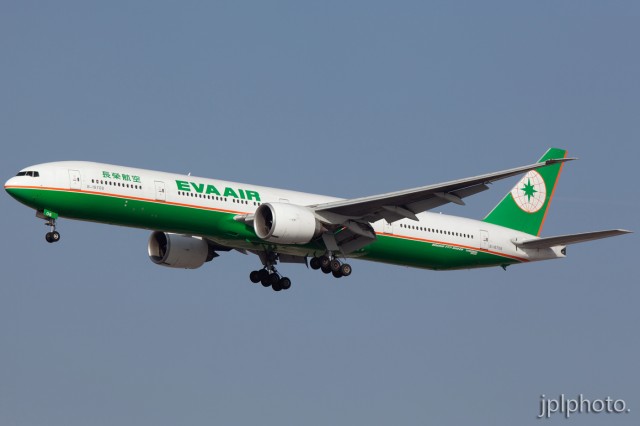
EVA Air Boeing 777-300ER.
EVA Air is an airline based in Taiwain and was founded in 1989. They started flight operations on July 1, 1991 and today they fly to over 40 international destinations.
The airline has mostly an all wide-body fleet of aircraft including the Airbus A330, Boeing 777 and the Boeing 747. They also have a small fleet of MD-90 aircraft.
The airline has a unique livery using green and orange. The green represents durability and the orange represents technological innovation. According to Wikipedia, “The tail globe logo is intended to represent stability and reliability, and its positioning on the tail, with one corner off the edge, represents service innovation.”
I feel that the livery is beautiful and best appreciated in person. I have heard from some that they aren’t as much of a fan of the orange and green, but you do not find many airlines showing off green and especially with orange. The previous generation of livery still had the green and orange striping, but had a bit too much white.
Image: Jeremy Dwyer-Li ndgren
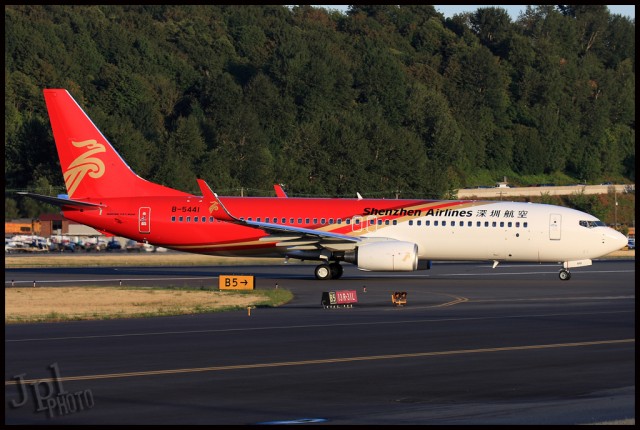
Shenzhen Airlines Boeing 737-800. Recent livery change means that it is hard to read the airline's name.
Shenzhen Airlines is the fourth largest domestic airline operating in China and started flying passengers in 1993. They have a fleet of over 100 aircraft, including the Boeing 737 and Airbus A320. Shenzhen is planning to have 180 aircraft by 2015.
The back part of their livery is red, with the front half white. They have recently made a change to make the red area longer, which works well in theory, but in practice it has caused problems with being able to read their titles. Looking at the older version of their livery, the full “Shenzhen Airlines” is all on the white. The new paint scheme puts the airline’s name partially on the white, but also partially on the red and gold striping, making it very difficult to read at a distance.
The tail sports the “National Roc.” According to the airline’s website this is “the totem aggregating the traditional and modern Chinese cultures. The design is harmonious and the colors of red and gold are gloriously lined with one on the other, agglomerating the soul of the oriental culture. Tallness and straightness, fullness of vitality, are the reflection of progress and prompt response.”
Overall, I think it is a great livery, my only suggestion would be to move the English titles back onto the red and make them white.
Photo by Jeremy Dwyer-Lindgren
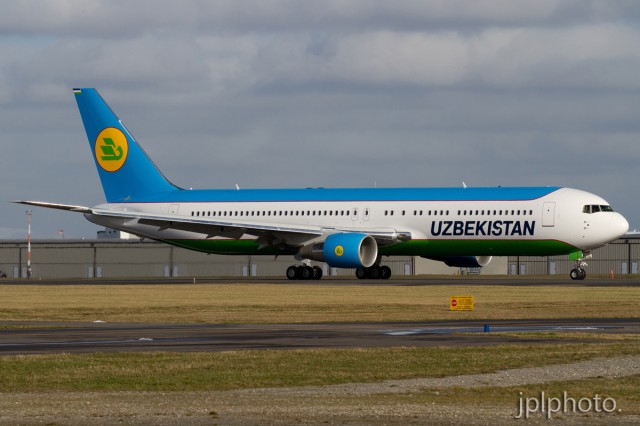
Brand New Uzbekistan Boeing 767-300ER (UK67003) at Paine Field. Photo by Jeremy Dwyer-Lindgren.
Uzbekistan Airways is the national airline of Uzbekistan and started operations on May 31, 1992 after taking over service of Aeroflot’s service in the region. The carrier has a mixed fleet of aircraft including the Airbus A310, Airbus A320, Antonov-24, Avro RJ85, Boeing 757-200, Boeing 767-300ER, Ilyushin Il-114 and the Yak-40. The airline also has orders for two Boeing 787 Dreamliners.
This is one livery that surely stands out. Normally Boeing 767s at Paine Field do not stand out amount the 747s and 787s, but the Uzbekistan livery forces one to take notice. The first time I saw it, I was a bit shocked, but now it has started to grow a bit on me.
So why would an airline paint their aircraft to be light blue up top, white in the middle and green on the bottom with red lines seperating them? Well, take a look at the Uzbekistan flag and you get a pretty good idea of their thought process.
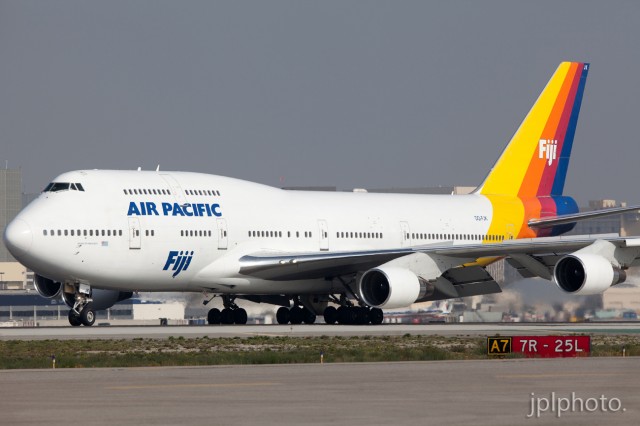
Air Pacific Boeing 747-400 seen at Los Angeles (LAX).
Air Pacific was founded in 1947 and is the flag carrier of Fiji. Currently the airline is 51% owned by the Fijian government and a little over 46% owned by Qantas Airlines.
The airline operates a fleet of only six aircraft consisting of 2 Boeing 747-400s, and four Boeing 737s. They have orders for three Airbus A330s that they hope to put into service in March 2013 to replace their aging 747s. The A330s will be the airline’s first time purchasing brand new aircraft. Previously, Air Pacific had an order for eight Boeing 787s, but all eight were cancelled in April of 2011.
I know there are many folks who do not like liveries with a white fuselage, but I think the tail more than makes up for the white. Although the livery does look good on the Boeing 737, I think it is really at home on the 747.
Image: Jeremy Dwyer-Lindgren
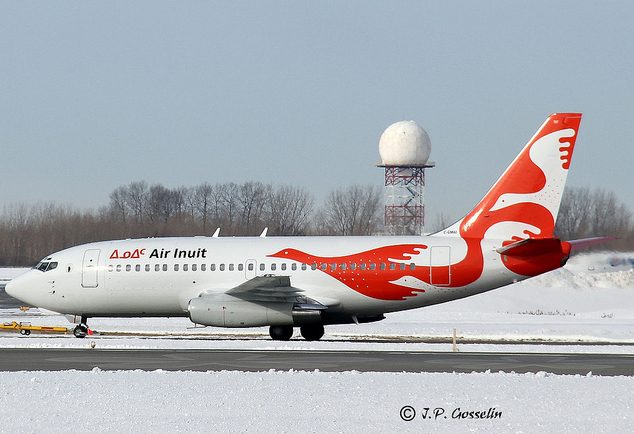
One of Air Inuit Boeing 737-200s (C-GMAI) taken in Montreal. CLICK FOR LARGER.
Air Inuit was founded in November 1978 and is based in Dorval, Quebec, Canada. The airline operates north — way north into Nunavik and Nunavut. Many of their destinations are isolated and cut off from the rest of the world. The airline becomes an integral part of many communities being able to survive.
When Air Inuit started operating up north, there was almost no aviation infrastructure and the airline had to get creative. From their website:
“When we first began flying to remote communities along our coasts, we faced many unique challenges. In the beginning, winter ice strips were built with community participation. In summer, improvised tundra strips had to be marked out. Dispatchers or pilots often radioed ahead, alerting the people to illuminate the community’s landing strip with the headlights of their ATV’s or snowmobiles.”
Today, Air Inuit operates a diverse fleet of older aircraft including the: DHC6 Twin Otter, Avro 748, Boeing 737-200 combi (be sure to catch the ski gravel deflector on the front landing gear), Dash 8 and King Air.
The photo shown on this post highlights Air Inuit’s new “goose livery.” Their older livery was not too shabby with some simple lines, but this new one is pretty darn slick and the orange really stands out against the snow.
Are you able to see the three geese on the tail?
Edit: Thanks to reader Ken Fielding for pointing out the gravel deflector not being a ski, “Airlines operating regularly into gravel strips, as Air Inuit do, fit them to stop the nosewheel kicking up stones which can be ingested by the engines. Quite a few MD-80’s had them fitted too for the same reason.”
Image: J P Gosselin




